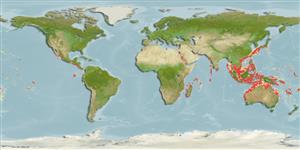Classification / Names
Common names from other countries
Main reference
Size / Weight / Age
Max length : 330 cm TL male/unsexed; (Ref. 30573); max. published weight: 150.0 kg (Ref. 11228)
Length at first maturity
Lm ?, range 100 - 110 cm
Environment
Marine; reef-associated; depth range 1 - 500 m (Ref. 37816), usually 20 - 60 m (Ref. 30573)
Climate / Range
Tropical, preferred ?; 41°N - 36°S, 25°E - 77°W
Distribution
Indo-West Pacific: Persian Gulf (Ref. 68964), Red Sea and East Africa to southern Japan, Micronesia, tropical Australia and Lord Howe Island. Eastern Pacific: known only from oceanic islands (Cocos and the Galapagos) but because of sheer number, individuals may colonize the Central America mainland (Ref. 28023). More widely known as Taeniura melanospila Bleeker 1853, a junior synonym based on the description of a juvenile specimen.
Countries | FAO areas | Ecosystems | Occurrences | Introductions
Short description
A large stingray with a circular disc, no thorns, a black and white mottled upper surface, and a deep and prominent ventral skin fold that extends to the tail tip (Ref. 6871).
IUCN Red List Status (Ref. 115185)
Human uses
Fisheries: commercial; gamefish: yes
More information
ReferencesAquacultureAquaculture profileStrainsGeneticsAllele frequenciesHeritabilityDiseasesProcessingMass conversion
Tools
Special reports
Download XML
Internet sources
Estimates of some properties based on models
Phylogenetic diversity index
PD50 = 1.0000 many relatives (e.g. carps) 0.5 - 2.0 few relatives (e.g. lungfishes)
Trophic Level
4.2 ±0.69 se; Based on food items.
Resilience
Very Low, minimum population doubling time more than 14 years (Fec=7)
Vulnerability
Very high vulnerability (77 of 100)
Price category
